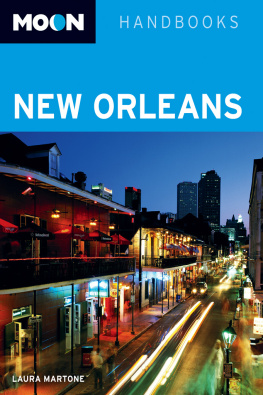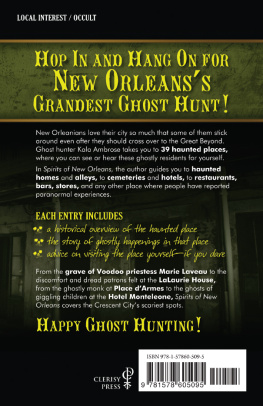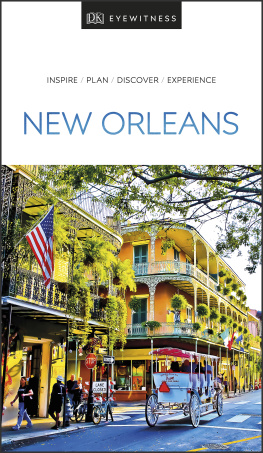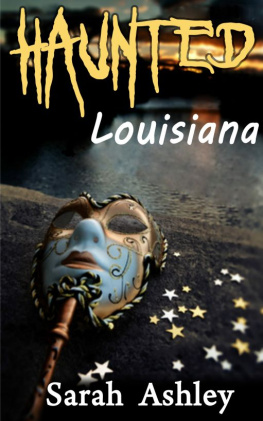New Orleans is recognized world-wide as a unique cultural region known for its eclectic mix of food, music, literature, folklore, style of speech, traditions, celebrations, and living history. Its style is a mesmerizing blend of flavorful beignets and jambalaya, lively funeral marches and soulful jazz, Spanish architecture and French street signs, foggy nights and sweltering days, and busy public squares and quiet courtyards. The city fills the senses with delightful sights, sounds, and fragrances and presents endless opportunities for adventure. This is especially true in the oldest part of the city, the renowned Vieux Carr, more frequently referred to as the French Quarter. Here, three hundred years of history linger in the air and add dimensions to the experience that many describe as supernatural.
New Orleans is, in every way, an important modern city of renowned institutions of higher learning and research and a vital center for energy industries and agriculture. But it is also a very old city that has found a way to preserve its heritage and share ancient secrets, historical legacies, and sights and sounds of past eras with travelers from all over the world. History, architecture, and culinary experiences can be found everywhere in the Crescent City. Ghosts can be found there too.
Within the American paranormal community, New Orleans is believed to be the most haunted place in the United States. Indeed, New Orleans and its nearby communities have all the ingredients necessary to sustain a legacy of ghosts, hauntings, and bizarre encounters with the paranormal. For some people, the very word ghost immediately brings to mind visions of ancient European castles, foggy moors, and dark, wind-swept ramparts where brave knights battled enemies of the crown. But the truth is that ghosts are everywhere. A history based in antiquity and covered with a veil of sorrow and pain from cultural upheaval is not essential, yet these elements are quite common in New Orleans.
To understand why ghosts haunt this fascinating city, we must know something of its history and traditions and look for clues in the tantalizing rumors and folklore that add a hint of romance, whispers of intrigue, and a thrill of adventure to our quest. Natural disasters, the fusion of cultures, wars, hurricanes, fires, and epidemics have all left indelible marks on the land, buildings, and people of the city. Ghosts seem to be attracted to places where the human experience was charged with great energy arising from pain, misery, and despair but also happiness, triumph, and great elation. If you visit those special places in New Orleans where these human experiences played out, you will find the ghosts of an amazing people who lived the history of a fascinating city.
In 1699, when French explorers arrived at the site that would become the Crescent City, they found an inhospitable land comprised of swamps, clouds of insects, brutal heat and high humidity, and frequent floods rising from the Mississippi River. Situated on what appeared to be high ground between Lake Pontchartrain and the Mississippi River, the place showed great promise as a commercial center because of its easy access to waterborne transportation. It was another 20 years, however, before the town of La Nouvelle-Orlans was founded and the construction of levees, streets, and plantations began.
At first, only a small community settled in the swampland. The settlers quickly realized that in order to meet the population goals set by Europeans who had invested in the settlement, it would be necessary to recruit artisans and workers from France and her colonies. Apparently, the place had already gained a reputation throughout Europe and the Caribbean for its harsh climate and other hardships, so few volunteered. The only viable solution was to recruit workers from French prisons by offering them freedom if they would immigrate to the new city on the Mississippi. The initial wave of these immigrants was, naturally, predominantly men of rough character and this created obvious difficulties. It was reported that so few young women were available in La Nouvelle-Orlans that the male residents often ran into the woods searching for Native American girls. This behavior may have been the initial venture into what would become a common trait of blending ethnicities, but it threatened peaceful relations with local tribes. The quickest solution was to offer incarcerated prostitutes in France the same opportunity that had been given the men: immigrate to the new colony or remain in jail.
While the towns population grew, civility was rare and the place became a wild frontier town ripe with crime and debauchery. Noting sharp distinctions between the small community of aristocrats and the growing population of uncouth laborers, Governor Bienville invited the Ursuline sisters to relocate from France to establish a convent and facilities for education and medical care. By 1727, the first Ursulines arrived and made an immediate positive impact on the citys lower classes which, in turn, attracted more investors as well as educated and middle-class immigrants. The Old Ursuline Convent still stands in the French Quarter.
By the late 1750s, conflicts with local Native Americans had been quelled and the colonys population and economy were stable, yet investors in France looked upon the New Orleans colony as a failure. Anticipating an economic disaster at home, in 1762, France relinquished ownership of the colony to Spain in the secret Treaty of Fontainebleau. On the day news of the treaty reached La Nouvelle-Orl a ns, 7,000 French colonists awoke to find that they had become subjects of the Spanish crown. The loyal French citizens were indignant, and the animosity that arose between the local French and Spanish would lead to a failed revolution and years of harsh martial law.
Throughout 40 years of Spanish rule, New Orleans fulfilled its promise of economic prosperity, developing a large, cultured upper class and military importance. But in 1800, the people awoke once again to find that the city had been deeded back to France by yet another secret treaty. Celebrations were widespread and residents began to describe their city as the Paris of the West, but in 1803, New Orleans changed hands once again. The Louisiana Purchase, ratified in the Cabildo, the seat of the colonys colonial government, transferred New Orleans to the United States. Despite attempts by the British to invade the city in 1814 and capture the lower Mississippi River region, New Orleans would never again be ruled by a European power.
Through these many transitional periods, the influx of diverse immigrants changed the character of the city and Louisiana. The most distinctive groups associated with Louisiana emerged during its colonial period. The descendants of the wealthy and educated French immigrants who arrived after the Ursulines became known as Creoles and comprised the preeminent social class in the city. Later another ethnic group composed of Catholics of mixed race began to use the descriptor.
The second group unique to Louisiana would become known as the Cajuns. Cajuns of southern Louisiana are descendants of French immigrants who originally settled in Canadas Maritime provinces between 1710 and 1750. On Giovanni da Verrazzanos 16th - century map of the Atlantic coast, the region was labeled Arcadia from the Greek meaning refuge. A century later, maps were prepared in which the r was omitted, altering the name of the place to Acadia. Those who settled there became known as Acadians. The term Cajun evolved from the French pronunciation of the word Acadian .
During the Seven Years War (1755-1763), the allegiance of Acadians to France and their civilian opposition to British military campaigns created grave concern that their militias might add significantly to the power of the French army. In order to reduce that threat, Acadians were deported to various countries, including the 13 American colonies and the French colony of Louisiana, during the Great Expulsion. In this period, more than 11,000 Acadians were deported. After the war, the Treaty of Paris (1763) granted an 18 - month period of unrestricted immigration for all who wished to leave the newly captured British territory. Many chose to immigrate to Louisiana, only to find that the colony had recently become a Spanish province. Still, the predominant culture of the region was French and many anticipated easy assimilation. Owing to their settlement in unclaimed lands thick with forests, bayous, and mosquito-infested swamps, many Acadian settlements were isolated. Their strange dialect, later known as Cajun-French, poverty, and illiteracy further set them apart from French people already established in Louisiana. Isolation of Cajun communities continued until the Civil War, but a few decades were sufficient to create a unique culture of language, food, music, and literature that flourishes throughout the state today.








